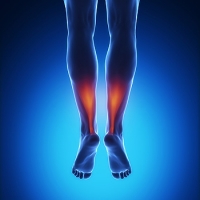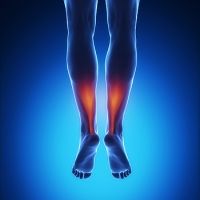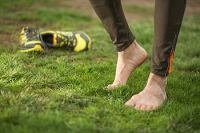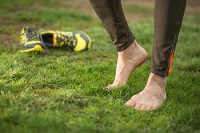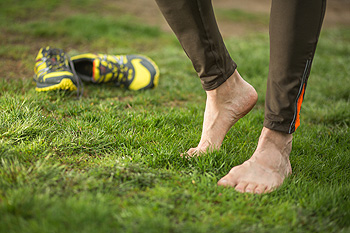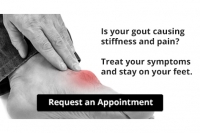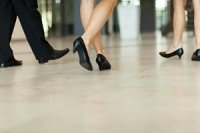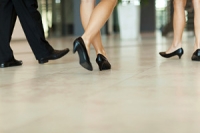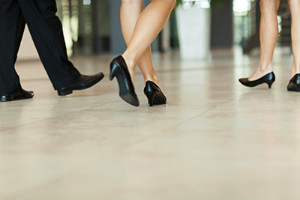
Blog (791)
How Do Achilles Tendon Injuries Occur?
There are two muscles in the calf that make up the Achilles tendon. It is considered to be the strongest tendon in the body, and it connects the heel to calf. An Achilles tendon injury can gradually occur from repetitive motion, or from suddenly twisting the leg while participating in running and jumping activities. This condition is generally accompanied by severe pain and discomfort, and it is often difficult to walk. Patients who have this type of injury may find mild relief when simple stretches are performed. These can include standing on a step while lowering the heel until a gentle stretch is felt. Strengthening the foot may be a solution in preventing Achilles tendon injuries from occurring. If you have this type of pain, please consult with a podiatrist who can effectively treat this condition.
Achilles tendon injuries need immediate attention to avoid future complications. If you have any concerns, contact Dr. Kenneth Donovan of Advanced Care Foot and Ankle. Our doctor can provide the care you need to keep you pain-free and on your feet.
What Is the Achilles Tendon?
The Achilles tendon is a tendon that connects the lower leg muscles and calf to the heel of the foot. It is the strongest tendon in the human body and is essential for making movement possible. Because this tendon is such an integral part of the body, any injuries to it can create immense difficulties and should immediately be presented to a doctor.
What Are the Symptoms of an Achilles Tendon Injury?
There are various types of injuries that can affect the Achilles tendon. The two most common injuries are Achilles tendinitis and ruptures of the tendon.
Achilles Tendinitis Symptoms
- Inflammation
- Dull to severe pain
- Increased blood flow to the tendon
- Thickening of the tendon
Rupture Symptoms
- Extreme pain and swelling in the foot
- Total immobility
Treatment and Prevention
Achilles tendon injuries are diagnosed by a thorough physical evaluation, which can include an MRI. Treatment involves rest, physical therapy, and in some cases, surgery. However, various preventative measures can be taken to avoid these injuries, such as:
- Thorough stretching of the tendon before and after exercise
- Strengthening exercises like calf raises, squats, leg curls, leg extensions, leg raises, lunges, and leg presses
If you have any questions please feel free to contact one of our offices located in Warren, Livingston, and Toms River, NJ . We offer the newest diagnostic tools and technology to treat your foot and ankle needs.
How Do Achilles Tendon Injuries Occur?
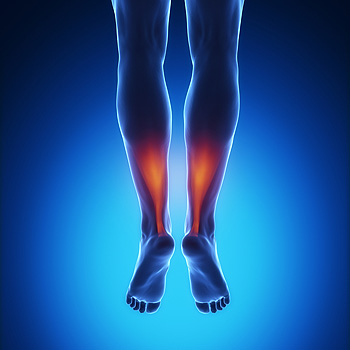 There are two muscles in the calf that make up the Achilles tendon. It is considered to be the strongest tendon in the body, and it connects the heel to calf. An Achilles tendon injury can gradually occur from repetitive motion, or from suddenly twisting the leg while participating in running and jumping activities. This condition is generally accompanied by severe pain and discomfort, and it is often difficult to walk. Patients who have this type of injury may find mild relief when simple stretches are performed. These can include standing on a step while lowering the heel until a gentle stretch is felt. Strengthening the foot may be a solution in preventing Achilles tendon injuries from occurring. If you have this type of pain, please consult with a podiatrist who can effectively treat this condition.
There are two muscles in the calf that make up the Achilles tendon. It is considered to be the strongest tendon in the body, and it connects the heel to calf. An Achilles tendon injury can gradually occur from repetitive motion, or from suddenly twisting the leg while participating in running and jumping activities. This condition is generally accompanied by severe pain and discomfort, and it is often difficult to walk. Patients who have this type of injury may find mild relief when simple stretches are performed. These can include standing on a step while lowering the heel until a gentle stretch is felt. Strengthening the foot may be a solution in preventing Achilles tendon injuries from occurring. If you have this type of pain, please consult with a podiatrist who can effectively treat this condition.
Achilles tendon injuries need immediate attention to avoid future complications. If you have any concerns, contact Dr. Kenneth Donovan of Advanced Care Foot and Ankle. Our doctor can provide the care you need to keep you pain-free and on your feet.
What Is the Achilles Tendon?
The Achilles tendon is a tendon that connects the lower leg muscles and calf to the heel of the foot. It is the strongest tendon in the human body and is essential for making movement possible. Because this tendon is such an integral part of the body, any injuries to it can create immense difficulties and should immediately be presented to a doctor.
What Are the Symptoms of an Achilles Tendon Injury?
There are various types of injuries that can affect the Achilles tendon. The two most common injuries are Achilles tendinitis and ruptures of the tendon.
Achilles Tendinitis Symptoms
- Inflammation
- Dull to severe pain
- Increased blood flow to the tendon
- Thickening of the tendon
Rupture Symptoms
- Extreme pain and swelling in the foot
- Total immobility
Treatment and Prevention
Achilles tendon injuries are diagnosed by a thorough physical evaluation, which can include an MRI. Treatment involves rest, physical therapy, and in some cases, surgery. However, various preventative measures can be taken to avoid these injuries, such as:
- Thorough stretching of the tendon before and after exercise
- Strengthening exercises like calf raises, squats, leg curls, leg extensions, leg raises, lunges, and leg presses
If you have any questions please feel free to contact one of our offices located in Warren, Livingston, and Toms River, NJ . We offer the newest diagnostic tools and technology to treat your foot and ankle needs.
Complications of Excessive Sweating in the Feet
Everybody sweats from their feet, but sometimes, the amount of sweat can be too much. Excessive foot sweat is an indicator of plantar hyperhidrosis, which is a medical condition where the sweat glands produce too much sweat in conditions that would not normally cause much sweating. If you have plantar hyperhidrosis, seeking treatment is recommended. This is because sweating excessively from your feet can lead to various complications. These can include an increase in the risk of developing cuts and breaks in the skin, which can lead to foot infections, such as athlete’s foot. Infections can be especially dangerous if you have other health problems that affect the feet, like diabetes, peripheral neuropathy, or peripheral artery disease. Excessive foot sweat can also be embarrassing, leading to psychological distress and avoidance of certain social situations. To learn more about plantar hyperhidrosis and the treatments available for this condition, please speak with a podiatrist.
If you are suffering from hyperhidrosis contact Dr. Kenneth Donovan of Advanced Care Foot and Ankle. Our doctor can provide the care you need to attend to all of your foot and ankle needs.
Hyperhidrosis of the Feet
Hyperhidrosis is a rare disorder that can cause people to have excessive sweating of their feet. This can usually occur all on its own without rigorous activity involved. People who suffer from hyperhidrosis may also experience sweaty palms.
Although it is said that sweating is a healthy process meant to cool down the body temperature and to maintain a proper internal temperature, hyperhidrosis may prove to be a huge hindrance on a person’s everyday life.
Plantar hyperhidrosis is considered to be the main form of hyperhidrosis. Secondary hyperhidrosis can refer to sweating that occurs in areas other than the feet or hands and armpits. Often this may be a sign of it being related to another medical condition such as menopause, hyperthyroidism and even Parkinson’s disease.
In order to alleviate this condition, it is important to see your doctor so that they may prescribe the necessary medications so that you can begin to live a normal life again. If this is left untreated, it is said that it will persist throughout an individual’s life.
A last resort approach would be surgery, but it is best to speak with your doctor to find out what may be the best treatment for you.
If you have any questions please feel free to contact one of our offices located in Warren, Livingston, and Toms River, NJ . We offer the newest diagnostic and treatment technologies for all your foot and ankle needs.
Complications of Excessive Sweating in the Feet
Everybody sweats from their feet, but sometimes, the amount of sweat can be too much. Excessive foot sweat is an indicator of plantar hyperhidrosis, which is a medical condition where the sweat glands produce too much sweat in conditions that would not normally cause much sweating. If you have plantar hyperhidrosis, seeking treatment is recommended. This is because sweating excessively from your feet can lead to various complications. These can include an increase in the risk of developing cuts and breaks in the skin, which can lead to foot infections, such as athlete’s foot. Infections can be especially dangerous if you have other health problems that affect the feet, like diabetes, peripheral neuropathy, or peripheral artery disease. Excessive foot sweat can also be embarrassing, leading to psychological distress and avoidance of certain social situations. To learn more about plantar hyperhidrosis and the treatments available for this condition, please speak with a podiatrist.
If you are suffering from hyperhidrosis contact Dr. Kenneth Donovan of Advanced Care Foot and Ankle. Our doctor can provide the care you need to attend to all of your foot and ankle needs.
Hyperhidrosis of the Feet
Hyperhidrosis is a rare disorder that can cause people to have excessive sweating of their feet. This can usually occur all on its own without rigorous activity involved. People who suffer from hyperhidrosis may also experience sweaty palms.
Although it is said that sweating is a healthy process meant to cool down the body temperature and to maintain a proper internal temperature, hyperhidrosis may prove to be a huge hindrance on a person’s everyday life.
Plantar hyperhidrosis is considered to be the main form of hyperhidrosis. Secondary hyperhidrosis can refer to sweating that occurs in areas other than the feet or hands and armpits. Often this may be a sign of it being related to another medical condition such as menopause, hyperthyroidism and even Parkinson’s disease.
In order to alleviate this condition, it is important to see your doctor so that they may prescribe the necessary medications so that you can begin to live a normal life again. If this is left untreated, it is said that it will persist throughout an individual’s life.
A last resort approach would be surgery, but it is best to speak with your doctor to find out what may be the best treatment for you.
If you have any questions please feel free to contact one of our offices located in Warren, Livingston, and Toms River, NJ . We offer the newest diagnostic and treatment technologies for all your foot and ankle needs.
Gout Pain Can Be Managed
Gout Pain Can Be Managed
Two Types of Toe Fractures
A broken toe is often confirmed by having an X-ray taken. This type of fracture can happen from dropping a heavy object on the toe, or from stubbing the toe against a piece of furniture. There are two categories that the majority of toe fractures fall into, stress or traumatic. A stress fracture can gradually develop, and this typically occurs from repetitive overuse, which may come from running. A traumatic fracture is generally the result of a sudden injury, and can cause severe pain and discomfort. An effective healing process may include buddy taping. This is accomplished by taping the affected toe to the toe next to it, and this is often helpful in providing the necessary support as the affected toe heals. If you have a broken toe, please consult with a podiatrist who can treat this condition.
A broken toe can be very painful and lead to complications if not properly fixed. If you have any concerns about your feet, contact Dr. Kenneth Donovan from Advanced Care Foot and Ankle. Our doctor will treat your foot and ankle needs.
What to Know About a Broken Toe
Although most people try to avoid foot trauma such as banging, stubbing, or dropping heavy objects on their feet, the unfortunate fact is that it is a common occurrence. Given the fact that toes are positioned in front of the feet, they typically sustain the brunt of such trauma. When trauma occurs to a toe, the result can be a painful break (fracture).
Symptoms of a Broken Toe
- Throbbing pain
- Swelling
- Bruising on the skin and toenail
- The inability to move the toe
- Toe appears crooked or disfigured
- Tingling or numbness in the toe
Generally, it is best to stay off of the injured toe with the affected foot elevated.
Severe toe fractures may be treated with a splint, cast, and in some cases, minor surgery. Due to its position and the pressure it endures with daily activity, future complications can occur if the big toe is not properly treated.
If you have any questions please feel free to contact one of our offices located in Warren, Livingston, and Toms River, NJ . We offer the newest diagnostic and treatment technologies for all your foot and ankle needs.
Two Types of Toe Fractures
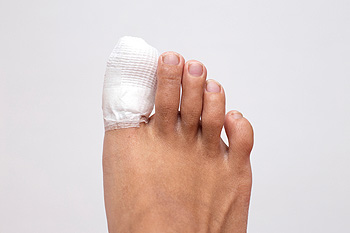 A broken toe is often confirmed by having an X-ray taken. This type of fracture can happen from dropping a heavy object on the toe, or from stubbing the toe against a piece of furniture. There are two categories that the majority of toe fractures fall into, stress or traumatic. A stress fracture can gradually develop, and this typically occurs from repetitive overuse, which may come from running. A traumatic fracture is generally the result of a sudden injury, and can cause severe pain and discomfort. An effective healing process may include buddy taping. This is accomplished by taping the affected toe to the toe next to it, and this is often helpful in providing the necessary support as the affected toe heals. If you have a broken toe, please consult with a podiatrist who can treat this condition.
A broken toe is often confirmed by having an X-ray taken. This type of fracture can happen from dropping a heavy object on the toe, or from stubbing the toe against a piece of furniture. There are two categories that the majority of toe fractures fall into, stress or traumatic. A stress fracture can gradually develop, and this typically occurs from repetitive overuse, which may come from running. A traumatic fracture is generally the result of a sudden injury, and can cause severe pain and discomfort. An effective healing process may include buddy taping. This is accomplished by taping the affected toe to the toe next to it, and this is often helpful in providing the necessary support as the affected toe heals. If you have a broken toe, please consult with a podiatrist who can treat this condition.
A broken toe can be very painful and lead to complications if not properly fixed. If you have any concerns about your feet, contact Dr. Kenneth Donovan from Advanced Care Foot and Ankle. Our doctor will treat your foot and ankle needs.
What to Know About a Broken Toe
Although most people try to avoid foot trauma such as banging, stubbing, or dropping heavy objects on their feet, the unfortunate fact is that it is a common occurrence. Given the fact that toes are positioned in front of the feet, they typically sustain the brunt of such trauma. When trauma occurs to a toe, the result can be a painful break (fracture).
Symptoms of a Broken Toe
- Throbbing pain
- Swelling
- Bruising on the skin and toenail
- The inability to move the toe
- Toe appears crooked or disfigured
- Tingling or numbness in the toe
Generally, it is best to stay off of the injured toe with the affected foot elevated.
Severe toe fractures may be treated with a splint, cast, and in some cases, minor surgery. Due to its position and the pressure it endures with daily activity, future complications can occur if the big toe is not properly treated.
If you have any questions please feel free to contact one of our offices located in Warren, Livingston, and Toms River, NJ . We offer the newest diagnostic and treatment technologies for all your foot and ankle needs.
Solutions to Standing All Day
Do you work on your feet and find yourself in pain by the end of the day? If so, this is not surprising. Standing all day can lead to many complications, including foot pain, plantar fasciitis, muscle fatigue, bunions, swollen feet and ankles, and Achilles tendonitis. While you may not be able to avoid frequent standing completely, there are some steps that you can take to give your feet a break. If possible, try to alternate standing with sitting throughout the day. Walk around, sit in different positions, and move regularly to help disperse your weight more evenly. Wearing comfortable and supportive shoes, special shoe inserts, or compression hose and socks may also help. Finally, performing foot and leg stretches regularly can strengthen your lower limbs and reduce your risk of developing various foot and ankle problems. For more advice on mitigating the foot and ankle complications from working on your feet, consult with a podiatrist today.
While working on the feet, it is important to take the proper care of them. For more information about working on your feet, contact Dr. Kenneth Donovan from Advanced Care Foot and Ankle. Our doctor will treat your foot and ankle needs.
Working on Your Feet
Standing on your feet for long periods of time can cause stress and pain in your feet. Your whole body may experience change in terms of posture, back pain, bunions, callouses and or plantar warts. There are ways to avoid these conditions with proper foot care, smart choices and correct posture.
Positive Changes
Negative heeled shoe – Choosing this shoe type places the heel slightly lower than the ball of the foot. These are great for overall foot health. Find shoes that fit you correctly.
Go barefoot – Our feet were not designed to be enclosed for all hours of the day. Try to periodically expose your feet to air.
Eliminate Pain
Foot Exercises – Performing simple exercises, incorporating yoga and doing stretches are beneficial. This will allow increased blood flow to the area and muscles of the foot.
Achilles tendon – Stretching the foot out flat on the floor will relax the calf muscles and tendon. These exercises can be performed almost anywhere. Make sure you add these exercises to your daily regimen.
With a little bit of this information and knowing more about foot health, you will notice changes. Foot stretches and proper footwear will help with pain and prevent further issues.
If you have any questions please feel free to contact one of our offices located in Warren, Livingston, and Toms River, NJ . We offer the newest diagnostic and treatment technologies for all your foot and ankle needs.
Solutions to Standing All Day
Do you work on your feet and find yourself in pain by the end of the day? If so, this is not surprising. Standing all day can lead to many complications, including foot pain, plantar fasciitis, muscle fatigue, bunions, swollen feet and ankles, and Achilles tendonitis. While you may not be able to avoid frequent standing completely, there are some steps that you can take to give your feet a break. If possible, try to alternate standing with sitting throughout the day. Walk around, sit in different positions, and move regularly to help disperse your weight more evenly. Wearing comfortable and supportive shoes, special shoe inserts, or compression hose and socks may also help. Finally, performing foot and leg stretches regularly can strengthen your lower limbs and reduce your risk of developing various foot and ankle problems. For more advice on mitigating the foot and ankle complications from working on your feet, consult with a podiatrist today.
While working on the feet, it is important to take the proper care of them. For more information about working on your feet, contact Dr. Kenneth Donovan from Advanced Care Foot and Ankle. Our doctor will treat your foot and ankle needs.
Working on Your Feet
Standing on your feet for long periods of time can cause stress and pain in your feet. Your whole body may experience change in terms of posture, back pain, bunions, callouses and or plantar warts. There are ways to avoid these conditions with proper foot care, smart choices and correct posture.
Positive Changes
Negative heeled shoe – Choosing this shoe type places the heel slightly lower than the ball of the foot. These are great for overall foot health. Find shoes that fit you correctly.
Go barefoot – Our feet were not designed to be enclosed for all hours of the day. Try to periodically expose your feet to air.
Eliminate Pain
Foot Exercises – Performing simple exercises, incorporating yoga and doing stretches are beneficial. This will allow increased blood flow to the area and muscles of the foot.
Achilles tendon – Stretching the foot out flat on the floor will relax the calf muscles and tendon. These exercises can be performed almost anywhere. Make sure you add these exercises to your daily regimen.
With a little bit of this information and knowing more about foot health, you will notice changes. Foot stretches and proper footwear will help with pain and prevent further issues.
If you have any questions please feel free to contact one of our offices located in Warren, Livingston, and Toms River, NJ . We offer the newest diagnostic and treatment technologies for all your foot and ankle needs.
